Moro de Guandules con Coco
Moro de Guandules con Coco is a mix of rice, guandules and coconut milk that results in a delicious and buttery seasoned rice that is perfect for any special occasion.

It’s the holidays, so that means the number of bowls of Moro I enjoy exponentially increases between making it myself at home and then visiting my family throughout the holiday season. One particular variety of Moro I enjoy is the one made with coconut milk.
Moro con coco is popular in the city of Samaná in the Dominican Republic. The addition of coconut milk adds a delicious buttery taste to the final rice. That extra richness and specialty of this dish often has me save it as my “special dish” for things like the holidays. What better time to pull out all the stops?
Why You’ll Love Moro con Coco
- Comfort in a bowl. Rice on it’s own is my comfort, and when that rice is seasoned and cooked with coconut it becomes even more special and indulgent. A true taste of comfort.
- Perfect to add to your holiday table. I feel like when I really want to impress, I make this rice. So this is my go to addition to my holiday table.
- Great to make in advance. While I love a freshly made pot of rice, this is also one of my favorite dishes to make ahead of time. It’s perfect if you can’t compromise stovetop space during any holiday. Just make the day before and reheat when ready to eat.

Key Ingredients and Substitutions
- Rice: It is best to use long grain white rice for this. My favorite variety to use is Jasmine rice as it has a lovely flavor to it that I feel works best with the seasonings.
- Peppers: My local market has bell peppers mostly, which I’ll use to make the base of the homemade sofrito. I like using a little more than I normally see others use, but that is my preference. If you have access to cubanelle peppers, these are great to use here.
- Onion: Use the variety you like. I used yellow onion, but red onion also works.
- Seasonings: I used a combination of adobo and sazón. Do note that some varieties have salt added or no salt added. I used salted varieties, so if you use something different, make sure to taste and season your broth as appropriate.
- Bouillon: Traditionally, a chicken bouillon cube (or “sopita” as I’ve grown up calling it) is used. I make mine using a good quality vegetable based bouillon cube or a vegan “chicken” bouillon paste equivalent like Better than Bouillon.
- Tomato Paste: Since we are using coconut milk, I decided to use tomato paste in the base of my rice.
- Coconut Milk: I recommend using canned full fat coconut milk.
- Guandules: You will also see this labeled as pigeon peas. You can find this in the international section of your store. If you don’t have access to this, while not the same, you can replace it for some pinto beans.
- Cilantro: This helps build our homemade sofrito. If not big on cilantro, you can leave it out or use a little parsley instead.
- Olives: Optional! That is for any olive haters, but if you are like me and love olives, I use Spanish olives. My Tia makes hers with olives and I look forward to it anytime she makes it.
How to Make Moro de Guandules con Coco
Heat 2 tbsp of oil in a large heavy bottom pot over medium low heat. Add the onions, bell pepper, garlic, and minced cilantro ends then sauté for about a minute until fragrant.
Stir in the sazón, adobo, olives, tomato paste and bouillon and continue to sauté until evenly mixed.
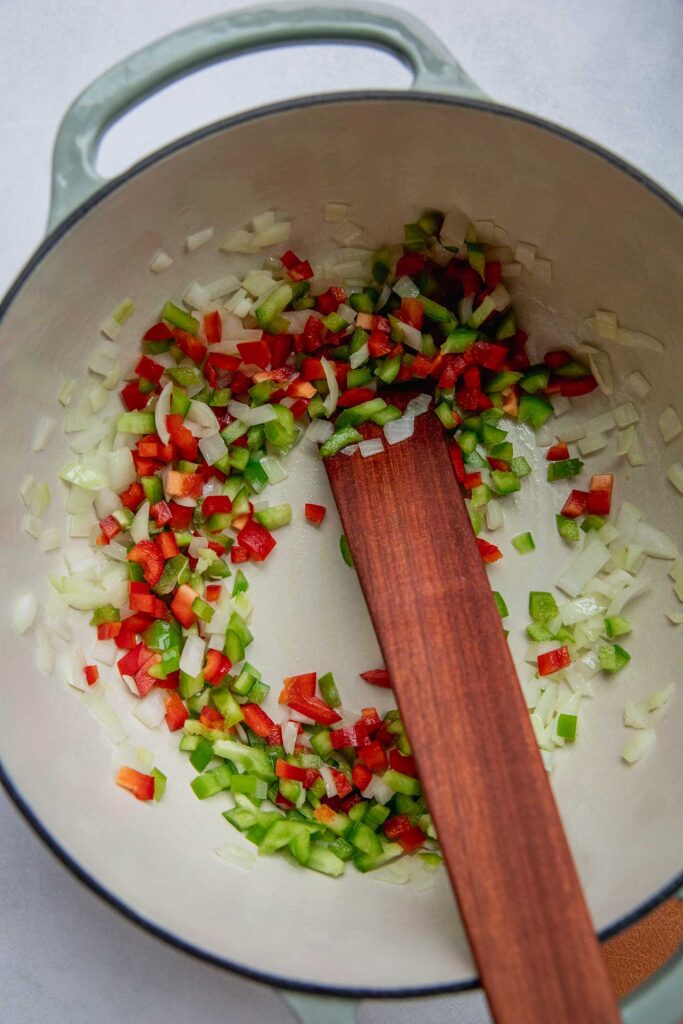
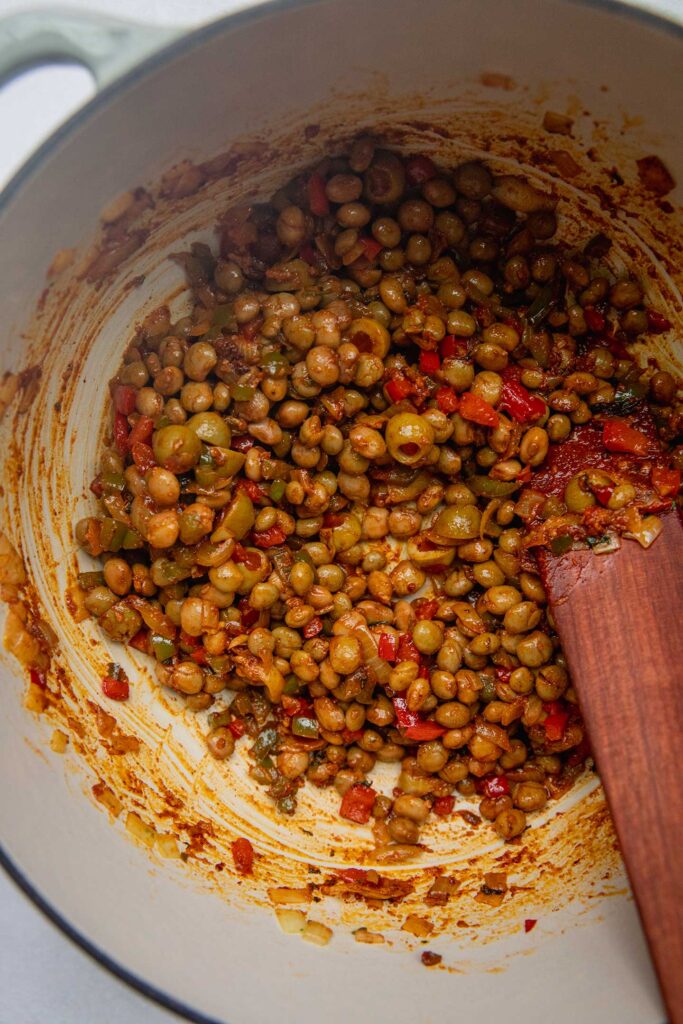
Pour in the guandules then stir well into the mixture. Taste the broth and if you feel it needs more salt, add a generous pinch. Once everything is well heated pour in the coconut milk and water then stir well and bring everything to a boil.


Stir in the rice and simmer over medium low heat, making sure to stir regularly to help prevent the rice from sticking to the bottom of the pot.
Now, wait until most of the liquid is evaporated. The rice should look glossy at this point. Add the remaining cilantro then cover with a tight fitting lid and lower the heat to low.


Steam the rice covered for 30 minutes, then remove the pot from heat. Keep the lid on and allow to rest for 10 minutes. Fluff your rice with a spoon, then serve and enjoy.
Expert Tips
- When rinsing your rice, make sure to drain it well before adding to the pot. This will help keep the amount of liquid in the pot more controlled, which will prevent your rice from getting mushy.
- Adjust salt to taste. I encourage you to taste your broth before adding the rice. This will give you an initial indication of how you want to adjust your salt. Different brands of bouillon will yield different amounts of sodium and flavor, so use the highest quality when possible . Add additional salt to taste as this will impact the flavor the most. The salt helps to bring out the flavors in your spices.
- Make sure you cover your pot tightly. You want a tight fitting lid over your pot of rice to help promote steaming. This will help get you that super fluffy rice.
- The Concón. This is just what we Dominicans call the crispy rice at the bottom of the pot. To us, this is one of the best parts of the pot. Do note, we don’t want to burn our rice, the bottom should be crispy, and nicely golden brown. This is best achieved when using a very wide pot.
- Use the amount of oil that feels right to you. There is fat in the coconut milk, so I primarily just use enough oil to coat the bottom of my pan to help properly saute the elements of our sazón. If you feel that anything is burning or sticking, you may just need more oil.
- Olives are optional. Maybe not to me, but if you don’t like olives, leaving them out is totally okay.
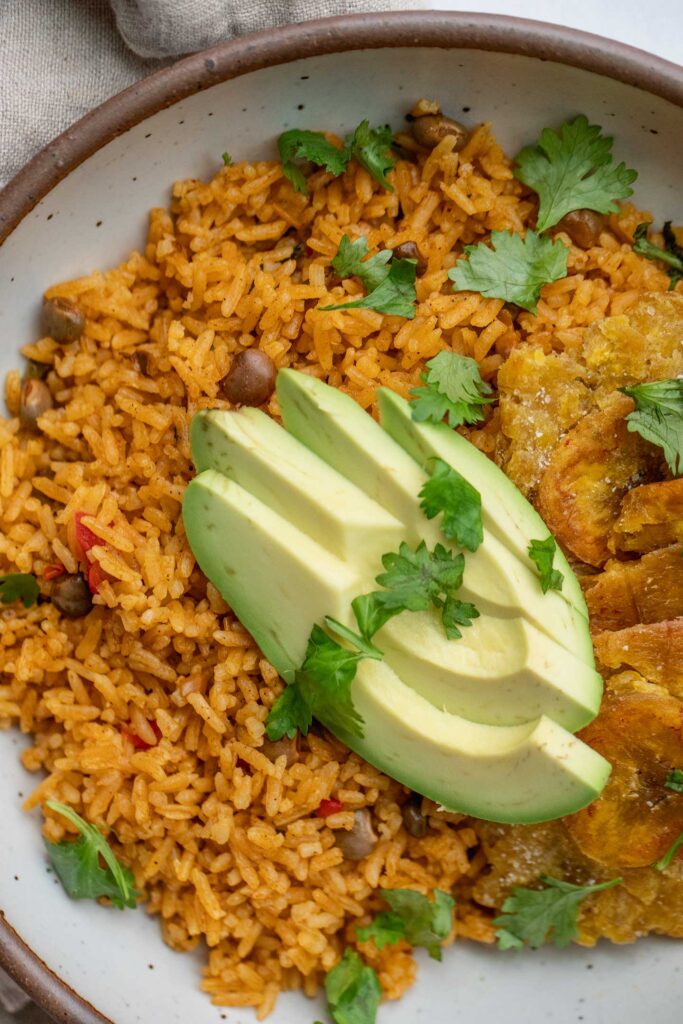
Learning to Adjust
When I first learned this recipe, I didn’t get exact measurements or tips on how to troubleshoot when using a different pot, stove top, or different types of rice. In fact, my Dominican mother like most mothers has always educated with sight and feeling. Two things that aren’t exactly easy to measure. Yes, measure with your heart is not an exact measure and sometimes you don’t truly understand what that means until you are in the process of cooking yourself.
Taste
My suggestion, is to adjust based on what you are seeing and tasting. For example, before you add the rice to your broth, give it a taste and see if it needs more seasoning. At this stage you can add more salt or extra adobo to get it tasting more like you want it.
Stove Top
I’ve made this rice using different pots, an electric burner, a gas stove top, etc. The thing that changes is the amount of heat you are using. With a gas stove top I generally keep the flame at the lowest setting when steaming (between 1-2 depending on the strength of the flame). For electric stove tops, I have found that for most (not all) I leave the setting between 3-4 (medium low). Remember, that stoves can vary, if you hit the cook time and your rice doesn’t look cooked, add 3-4 tbsp of water, cover with the lid and raise the heat slightly to help steam the rice for another 10 minutes.
Type of Pot
I’ve made this rice in so many different types of pots. I can confidently say, you can make this rice in just about any pot. Ideally, I would say it is best to use a large cast iron or cast aluminum pot. An aluminum pot is the traditional style pot that my mom uses all the time. The benefit is it’s width, which helps distribute heat more evenly, which gives you the ideal concón. Again, not necessary to get this pot, you can still absolutely make good rice with any pot.
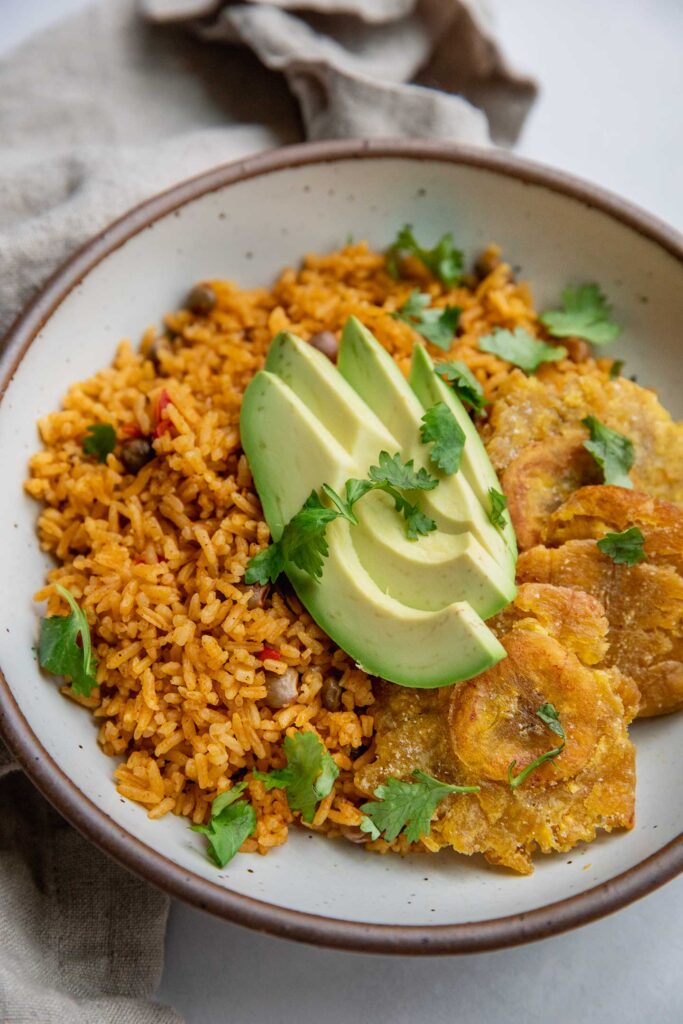
Frequently Asked Questions
Yes! Once cooled, place leftovers in an airtight storage container and store in the fridge for up to 3-4 days. You can also freeze this rice by storing in the freezer for up to 2 months. The rice reheats well, add the rice to a bowl with a cube of ice, cover and microwave for 1-2 minutes until warmed through to your liking (discard the ice cube after).
For ease, most grocery stores in the US that have an ethnic or international section of their grocery store will carry adobo and sazón. Some stores will carry different brands, so choose what you prefer. I personally like using the adobo and sazón from Loisa or Pisqueya.
If your rice didn’t steam through all the way it likely happened because your stove top burner runs a little hotter, which is totally okay. Add 3-4 tbsp of water, cover with a tight lid, and cook on the lowest heat for 10 minutes. Remove from heat and allow the rice to continue steaming off the stove top. This should help finish off the rice.
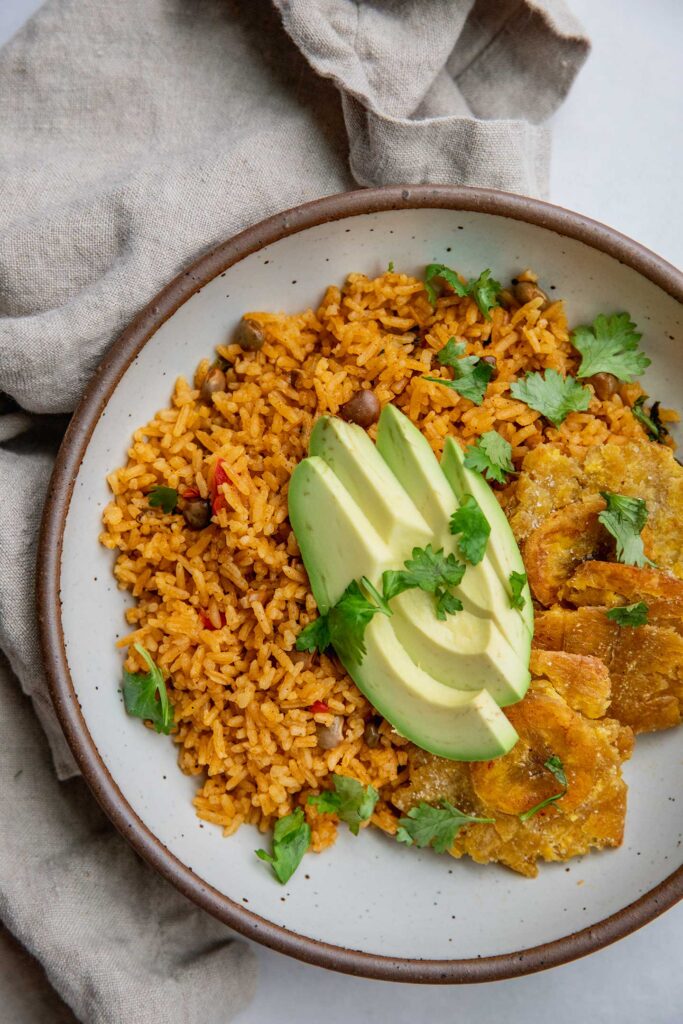
How to Serve
This rice is perfect to serve as a side with other forms of protein or vegetables based on your own preference. Normally, whenever my mother makes Moro during a gathering we always enjoy it with some platanos fritos and sliced avocado.
For protein, there are a number of different things you can enjoy this rice with. I personally will do a simple crispy tofu on the side. But for holidays I often enjoy this with some brown sugar glazed tofu or some vegan “pollo” guisado.
Some fun vegetables/fungi recipes you can enjoy this with include some roasted carrots or broccoli or this vegan pernil made with mushrooms.
More Holiday Recipes to Try
- Herb Roasted Chickpea Vegetable Wellington
- Garlic Sage Toasted Quinoa Salad
- Lemon Glazed Roasted Carrots and Rice Salad
- Maple Miso Whipped Sweet Potatoes with Cornmeal Crusted Tofu
- Roasted Tahini Cauliflower Steak with Lentils

If you tried this recipe or any other recipe on the blog, then let me know what you thought in the comments below! And if you loved it, don’t forget to rate it too. Feel free to follow on Instagram, Pinterest, and TikTok for the latest nutrition tips and recipe videos.
Print
Moro de Guandules con Coco
- Prep Time: 15 minutes
- Cook Time: 45 minutes
- Total Time: 1 hour
- Yield: 6 servings 1x
- Category: Sides
- Method: Stove Top
- Cuisine: Dominican
- Diet: Vegan
Description
Moro de Guandules con Coco is a mix of rice, guandules and coconut milk that results in a delicious and buttery seasoned rice that is perfect for any special occasion.
Ingredients
- 1–2 tbsp avocado oil
- 1/2 small yellow onion, diced
- 1/2 small green bell pepper, diced
- 1/2 small red bell pepper, diced
- 3 cloves of garlic, crushed or finely minced
- 1 small bunch cilantro, minced well
- 2 tsp sazón
- 1/2 tsp adobo
- 3 tbsp Spanish olives, halved (optional)
- 1 tbsp tomato paste
- 1 vegetable bouillon cube or 2 tsp vegetable bouillon paste
- 1, 15 oz can of guandules, rinsed and drained
- 1 1/2 cups full-fat canned coconut milk
- 2 1/2 cups water
- 3 cups Jasmine rice, rinsed
- Kosher salt
For serving: baked plantains, avocado slices, or hot sauce
Instructions
- Heat 2 tbsp of oil in a large heavy bottom pot over medium low heat. Add the onions, bell pepper, garlic, and minced cilantro ends then sauté for about a minute until fragrant.
- Stir in the sazón, adobo, olives, tomato paste and bouillon and continue to sauté until evenly mixed.
- Pour in the guandules then stir well into the mixture. Taste the broth and if you feel it needs more salt, add a generous pinch. Once everything is well heated pour in the coconut milk and water then stir well and bring everything to a boil.
- Stir in the rice and simmer over medium low heat, making sure to stir regularly to help prevent the rice from sticking to the bottom of the pot.
- Now, wait until most of the liquid is evaporated. The rice should look glossy at this point. Add the remaining cilantro then cover with a tight fitting lid and lower the heat to low.
- Steam the rice covered for 30 minutes, then remove the pot from heat. Keep the lid on and allow to rest for 10 minutes. Fluff your rice with a spoon, then serve and enjoy.
Notes
When rinsing your rice, make sure to drain it well before adding to the pot. This will help keep the amount of liquid in the pot more controlled, which will prevent your rice from getting mushy.
Adjust salt to taste. I encourage you to taste your broth before adding the rice. This will give you an initial indication of how you want to adjust your salt. Different brands of bouillon will yield different amounts of sodium and flavor, so use the highest quality when possible . Add additional salt to taste as this will impact the flavor the most. The salt helps to bring out the flavors in your spices.
Make sure you cover your pot tightly. You want a tight fitting lid over your pot of rice to help promote steaming.
The Concón. This is just what we Dominicans call the crispy rice at the bottom of the pot. To us, this is one of the best parts of the pot. Do note, we don’t want to burn our rice, the bottom should be crispy, and nicely golden brown. This is best achieved when using a very wide pot.
Use the amount of oil that feels right to you. There is fat in the coconut milk, so I primarily just use enough oil to coat the bottom of my pan to help properly sauté the elements of our sazón. If you feel that anything is burning or sticking, you may just need more oil.
Olives are optional. Maybe not to me, but if you don’t like olives, leaving them out is totally okay.
This post contains affiliate links which means I will make a small commission if you purchase from those links. I only recommend and share products that I know, trust and personally use myself!
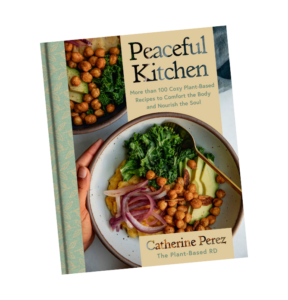





Easy to make! I had to make some substitutes so I hope I manage to capture the intended flavour !